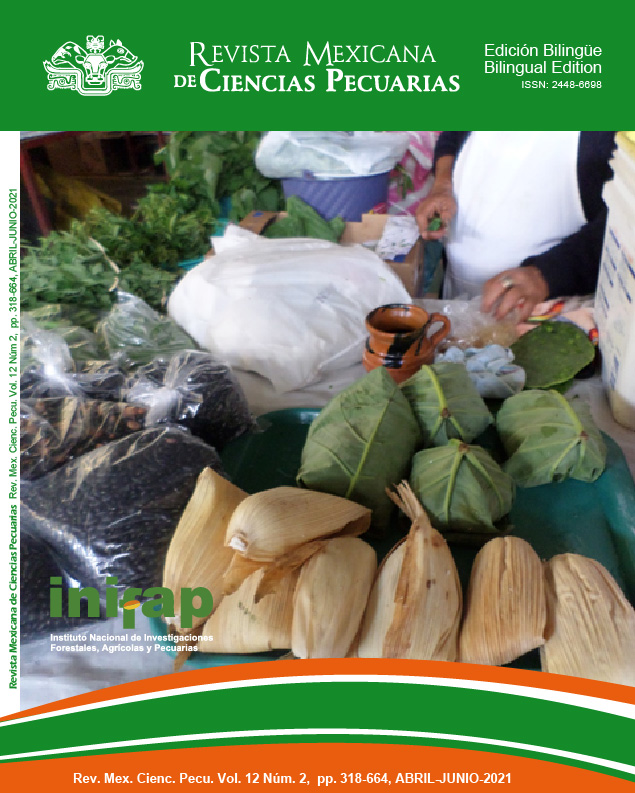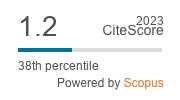Intracellular survival of Mycobacterium bovis strains with high and low frequency in cattle populations in a bovine macrophage model
DOI:
https://doi.org/10.22319/rmcp.v12i2.5542Palabras clave:
Mycobacterium bovis, Bovine tuberculosis, MacrophagesResumen
Bovine tuberculosis is a disease caused by Mycobacterium bovis that affects cattle and other species, including humans. Mycobacterium bovis resides mainly in macrophages, so bacilli survival within macrophages is related to virulence. Isolation and strain identification are important for disease control. However, little is known about virulence of the circulating strains in cattle populations. Therefore, the aim of this study was to compare the intracellular survival of Mycobacterium bovis strains with high and low frequency genotypes in cattle in Mexico. Four high frequency genotypes and four low frequency genotypes were identified and subjected to intracellular survival assays in bovine macrophages. Results showed that the phagocytosis proportion was approximately 63 % for all strains. There were no significant differences in the average Colony Forming Units (CFUs) in phagocytosis and survival between the high and low frequency groups; however, when the CFU average of phagocytosis was compared with the survival, significant differences were found in both groups. In intracellular growth, a significant difference was observed between low and high frequency strains, and between low frequency strains. Finally, the intracellular growth average of the groups was analyzed showing no significant difference. These results suggest that the frequency of the genotype in cattle population is not related to the intracellular survival and the virulence of the M. bovis strains.
Descargas
Citas
Pollock JM, Neill SD. Mycobacterium bovis infection and tuberculosis in cattle. Vet J Lond Engl 2002;163(2):115–127.
Gibson AL, Hewinson G, Goodchild T, Watt B, Story A, Inwald J, et al. Molecular epidemiology of disease due to Mycobacterium bovis in humans in the United Kingdom. J Clin Microbiol 2004;42(1):431–434.
Lari N, Rindi L, Bonanni D, Tortoli E, Garzelli C. Molecular analysis of clinical isolates of Mycobacterium bovis recovered from humans in Italy. J Clin Microbiol 2006;44(11):4218–4221.
Romero B, Aranaz A, de Juan L, Alvarez J, Bezos J, Mateos A, et al. Molecular epidemiology of multidrug-resistant Mycobacterium bovis isolates with the same spoligotyping profile as isolates from animals. J Clin Microbiol 2006;44(9):3405–3408.
Palmer MV, Waters WR, Thacker TC. Lesion development and immunohistochemical changes in granulomas from cattle experimentally infected with Mycobacterium bovis. Vet Pathol 2007;44(6):863–874.
García-Jiménez WL, Salguero FJ, Fernández-Llario P, Martínez R, Risco D, Gough J, et al. Immunopathology of granulomas produced by Mycobacterium bovis in naturally infected wild boar. Vet Immunol Immunopathol 2013;156(1–2):54–63.
Corner L, Melville L, McCubbin K, Small KJ, McCormick BS, Wood PR, et al. Efficiency of inspection procedures for the detection of tuberculous lesions in cattle. Aust Vet J 1990;67(11):389–392.
Domingo M, Vidal E, Marco A. Pathology of bovine tuberculosis. Res Vet Sci 2014;97 Suppl:S20-29.
Carrisoza-Urbina J, Morales-Salinas E, Bedolla-Alva MA, Hernández-Pando R, Gutiérrez-Pabello JA. Atypical granuloma formation in Mycobacterium bovis-infected calves. PloS One 2019;14(7):e0218547.
Bennett RM, Cooke RJ. Costs to farmers of a tuberculosis breakdown. Vet Rec 2006;158:429–432.
Boland F, Kelly GE, Good M, More SJ. Bovine tuberculosis and milk production in infected dairy herds in Ireland Prev Vet Med 2010;93(2–3):153–161.
Milián-Suazo F. Tuberculosis bovina en México: las bases. Primera ed. Ajuchitlan, Qro.: INIFAP. 2013.
González-Ruiz S, Sosa-Gallegos SL, Rodríguez-Hernández E, Flores-Villalva S, Román-Ponce SI, Bárcenas-Reyes I, et al. Genetic diversity of Mycobacterium bovis in Jalisco, Mexico: Tracing back sources of infection. J Vet Med Anim Health 2018;10(5):114–122.
Valway SE, Sanchez MP, Shinnick TF, Orme I, Agerton T, Hoy D, et al. An outbreak involving extensive transmission of a virulent strain of Mycobacterium tuberculosis. N Engl J Med 1998;338(10):633–639.
Caminero JA, Pena MJ, Campos-Herrero MI, Rodríguez JC, García I, Cabrera P, et al. Epidemiological evidence of the spread of a Mycobacterium tuberculosis strain of the Beijing genotype on Gran Canaria Island. Am J Respir Crit Care Med 2001;164(7):1165–1170.
López B, Aguilar D, Orozco H, Burger M, Espitia C, Ritacco V, et al. A marked difference in pathogenesis and immune response induced by different Mycobacterium tuberculosis genotypes. Clin Exp Immunol 2003;133(1):30–37.
Milián-Suazo F, Garcia-Casanova L, Robbe-Austerman S, Canto-Alarcón GJ, Bárcenas-Reyes I, Stuber T, et al. Molecular relationship between strains of M. bovis from Mexico and those from countries with free trade of cattle with Mexico. PloS One 2016;11(5):e0155207.
Zumárraga MJ, Arriaga C, Barandiaran S, Cobos-Marín L, de Waard J, Estrada-Garcia I, et al. Understanding the relationship between Mycobacterium bovis spoligotypes from cattle in Latin American countries. Res Vet Sci 2013;94(1):9–21.
Gutiérrez-Pabello JA, Adams LG. Sobrevivencia de Mycobacterium bovis en macrófagos de bovinos naturalmente resistentes y susceptibles a patógenos intracelulares. Vet México 2003;34(3):277–281.
Forrellad MA, Klepp LI, Gioffré A, Sabio y García J, Morbidoni HR, de la Paz Santangelo M, et al. Virulence factors of the Mycobacterium tuberculosis complex. Virulence 2013;4(1):3–66.
Qureshi T, Templeton JW, Adams LG. Intracellular survival of Brucella abortus, Mycobacterium bovis BCG, Salmonella dublin, and Salmonella typhimurium in macrophages from cattle genetically resistant to Brucella abortus. Vet Immunol Immunopathol 1996;50(1–2):55–65.
Milián Suazo F, García Casanova L, Romero Torres C, Cantó Alarcón GJ, Gutiérrez RJA, et al. Diversidad genética y distribución regional de cepas de Mycobacterium bovis del ganado en México. Rev Mex Cienc Pecu 2012;3(4):459–471.
Nava Vargas A, Milián Suazo F, Cantó Alarcón GJ, Rubio Venegas Y, Guerrero Solorio R, Rodríguez Hernández E, etal. Genetic diversity based on MIRU-VNTR profile of isolates of Mycobacterium bovis from Mexican cattle. Prev Vet Med 2016;131:75–78.
Perea Razo CA, Rodríguez Hernández E, Ponce SIR, Milián Suazo F, Robbe-Austerman S, Stuber T, et al. Molecular epidemiology of cattle tuberculosis in Mexico through whole-genome sequencing and spoligotyping. PLoS ONE 2018;13(8).
Milián-Suazo F, Salman MD, Black WC, Triantis JM, Ramírez CP, Payeur JB, et al. Molecular epidemiologic analysis of Mycobacterium bovis isolates from Mexico. Am J Vet Res 2000;61(1):90–95.
Gutiérrez Reyes JA, García Casanova L, Romero Torres C, Sosa Gallegos SL, Cantó Alarcón GJ, Mercado Pezzat M, etal. Population structure of Mycobacterium bovis isolates from cattle in Mexico. Prev Vet Med 2012;106(1):1–8.
Esquivel-Solís H, Vallecillo AJ, Benítez-Guzmán A, Adams LG, López-Vidal Y, Gutiérrez-Pabello JA. Nitric oxide not apoptosis mediates differential killing of Mycobacterium bovis in bovine macrophages. PloS One 2013;8(5):e63464.
Campbell GA, Adams LG. The long-term culture of bovine monocyte-derived macrophages and their use in the study of intracellular proliferation of Brucella abortus. Vet Immunol Immunopathol 1992;34(3–4):291–305.
Castillo-Velázquez U, Aranday-Cortés E, Gutiérrez-Pabello JA. Alternative activation modifies macrophage resistance to Mycobacterium bovis. Vet Microbiol 2011;151(1–2):51–59.
Garbaccio S, Macias A, Shimizu E, Paolicchi F, Pezzone N, Magnano G, et al. Association between spoligotype-VNTR types and virulence of Mycobacterium bovis in cattle. Virulence 2014;5(2):297–302.
Coker OO, Chaiprasert A, Ngamphiw C, Tongsima S, Regmi SM, Clark TG, et al. Genetic signatures of Mycobacterium tuberculosis Nonthaburi genotype revealed by whole genome analysis of isolates from tuberculous meningitis patients in Thailand. Peer J 2016;4:e1905.
Davis AS, Vergne I, Master SS, Kyei GB, Chua J, Deretic V. Mechanism of inducible nitric oxide synthase exclusion from mycobacterial phagosomes. PLoS Pathog 2007;3(12):e186.
Chávez-Galán L, Ángel M del CAD, Ovalle IS, Lascurain R. Principales mecanismos de evasión de la respuesta inmune por Mycobacterium tuberculosis. Gac Médica México. 2009;145(4):323–330.
Gupta A, Kaul A, Tsolaki AG, Kishore U, Bhakta S. Mycobacterium tuberculosis: immune evasion, latency and reactivation. Immunobiology 2012;217(3):363–74.
Medina E, Ryan L, LaCourse R, North RJ. Superior virulence of Mycobacterium bovis over Mycobacterium tuberculosis (Mtb) for Mtb-resistant and Mtb-susceptible mice is manifest as an ability to cause extrapulmonary disease. Tuberc Edinb Scotl 2006;86(1):20–27.
Aguilar LD, Zumárraga MJ, Jiménez OR, Gioffré AK, Bernardelli A, Orozco EH, et al. Mycobacterium bovis with different genotypes and from different hosts induce dissimilar immunopathological lesions in a mouse model of tuberculosis. Clin Exp Immunol 2009;157(1):139–147.
Wright DM, Allen AR, Mallon TR, McDowell SWJ, Bishop SC, Glass EJ, et al. Field-isolated genotypes of Mycobacterium bovis vary in virulence and influence case pathology but do not affect outbreak size. PloS One 2013;8(9):e74503.
de la Fuente J, Díez-Delgado I, Contreras M, Vicente J, Cabezas-Cruz A, Tobes R, et al. Comparative genomics of field isolates of Mycobacterium bovis and M. caprae provides evidence for possible correlates with bacterial viability and virulence. PLoS Negl Trop Dis 2015;9(11):e0004232.
Lee RS, Radomski N, Proulx JF, Levade I, Shapiro BJ, McIntosh F, et al. Population genomics of Mycobacterium tuberculosis in the Inuit. Proc Natl Acad Sci USA. 2015;112(44):13609–13614.
Cole ST, Brosch R, Parkhill J, Garnier T, Churcher C, Harris D, et al. Deciphering the biology of Mycobacterium tuberculosis from the complete genome sequence. Nature 1998;393(6685):537–544.
Descargas
Publicado
Cómo citar
-
Resumen863
-
PDF 417
-
PDF389
Número
Sección
Licencia
Los autores/as que publiquen en la Revista Mexicana de Ciencias Pecuarias aceptan las siguientes condiciones:
De acuerdo con la legislación de derechos de autor, la Revista Mexicana de Ciencias Pecuarias reconoce y respeta el derecho moral de los autores/as, así como la titularidad del derecho patrimonial, el cual será cedido a la revista para su difusión en acceso abierto.

Esta obra está bajo una Licencia Creative Commons Atribución-NoComercial-CompartirIgual 4.0 Internacional.





